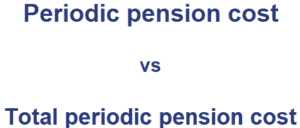Periodic Pension Cost (PPC)
The periodic pension cost (PPC) reported in the profit & loss (P&L) of a company income statement consists of several components:
- the current service cost
- the interest cost
- the expected return on plan assets
- the amortization of actuarial gains and losses
- the amortization of past service cost
On this page, we discuss each of these components in more detail. Note that this kind of pension cost is not the same as the total periodic pension cost. We discuss the difference between the two in more detail here as well.
Periodic pension cost components
The components are:
- current service cost: the present value of all benefits earned by the employees during the current period. This is expensed in the income statement.
- Interest cost: the increase in the PBO due to the passage of time. This component is also expensed in the income statement.
- Expected return on plan assets: this component offsets reported pension cost. Under U.S. GAAP, the expected rate of return is assumed. Under IFRS, the expected rate of return is the same as the discount rate.
- Amortization of actuarial gains and losses:
- Under U.S. GAAP only, the losses (or gains) during the year due to changes in actuarial assumptions and due to differences between expected and actual return are recognised in other comprehensive income (OCI) and amortized using the corridor method.
- under IFRS, the actuarial gains and losses during the year are recognised in OCI and are not amortized.
- Amortization of past service cost:
- under U.S. GAAP only, an increase in PBO resulting from plan amendments granting a retroactive increase in benefits is amortized.
- under IFRS, past service costs are immediately expensed in the income statement
Periodic pension cost versus total periodic pension cost
Total pension cost includes the costs reflected in the income statement (as we discussed above, i.e. the periodic pension cost) plus the costs that are included in OCI:
or
Summary
We discussed the PPC reported by companies in the income statement. Total periodic costs also include the costs reported in other comprehensive income.

